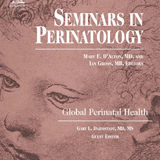
The December 2010 issue of Seminars in Perinatology examines global perinatal health, a timely topic in light of the unprecedented, high-level attention that has been given this past year to maternal, newborn, and child health.
Each year 3.6 million infants are estimated to die in the first 4 weeks of life (neonatal period)—but the majority continue to die at home, uncounted. This article reviews progress for newborn health globally, with a focus on the countries in which most deaths occur— what data do we have to guide accelerated efforts? All regions are advancing, but the level of decrease in neonatal mortality differs by region, country, and within countries. Progress also differs by the main causes of neonatal death. Three major causes of neonatal deaths (infections, complications of preterm birth, and intrapartum-related neonatal deaths or “birth asphyxia”) account for more than 80% of all neonatal deaths globally. The most rapid reductions have been made in reducing neonatal tetanus, and there has been apparent progress towards reducing neonatal infections. Limited, if any, reduction has been made in reducing global deaths from preterm birth and for intrapartum-related neonatal deaths. High-impact, feasible interventions to address these 3 causes are summarized in this article, along with estimates of potential for lives saved. A major gap is reaching mothers and babies at birth and in the early postnatal period. There are promising community-based service delivery models that have been tested mainly in research studies in Asia that are now being adapted and evaluated at scale and also being tested through a network of African implementation research trials. To meet Millennium Development Goal 4, more can and must be done to address neonatal deaths. A critical step is improving the quantity, quality and use of data to select and implement the most effective interventions and strengthen existing programs, especially at district level. >>Download resource and continue reading.
Free Access to editorial:
Additional articles in this issue:
>>Click to read the abstracts of the additional papers:*
Stillbirths: Epidemiology, Evidence, and Priorities for Action. Mohammad Yawar Yakoob, Joy E. Lawn, Gary L. Darmstadt, and Zul?qar A. Bhutta
Reducing Intrapartum-Related Neonatal Deaths in Low- and Middle-Income Countries—What Works? Stephen N. Wall, Anne CC Lee, Waldemar Carlo, Robert Goldenberg, Susan Niermeyer, Gary L. Darmstadt, William Keenan, Zul?qar A. Bhutta, Jeffrey Perlman, and Joy E. Lawn
Preventing Preterm Birth and Neonatal Mortality: Exploring the Epidemiology, Causes, and Interventions. LaVone E. Simmons, Craig E. Rubens, Gary L. Darmstadt, and Michael G. Gravett
Neonatal Infections in the Developing World. Hammad A. Ganatra and Anita K.M. Zaidi
Neonatal Hypothermia in Low-Resource Settings. Luke C. Mullany
Linkages Among Reproductive Health, Maternal Health, and Perinatal Outcomes. Zul?qar A. Bhutta, Zohra S. Lassi, Ann Blanc, and France Donnay
Behavior Change for Newborn Survival in Resource-Poor Community Settings: Bridging the Gap Between Evidence and Impact. Vishwajeet Kumar, Aarti Kumar, and Gary L. Darmstadt
Community-Based Intervention Packages for Improving Perinatal Health in Developing Countries: A Review of the Evidence. Jessica Schiffman, Gary L. Darmstadt, Siddharth Agarwal, and Abdullah H. Baqui
Why Is Continuum of Care from Home to Health Facilities Essential to Improve Perinatal Survival? Rajiv Bahl, Shamim Qazi, Gary L. Darmstadt, and Jose Martines
*Journal subscription required for full access to articles above.